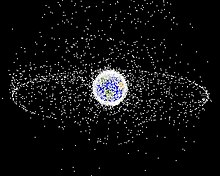Kessler Syndrome

The Kessler syndrome (or Kessler effect,[1][2] is a cascade effect. It was suggested by NASA scientist Donald J. Kessler in 1978. The scenario occurs when the space pollution is high enough for collisions between objects to occur.
There is a satellite in orbit that is large and inactive, making it count as space debris, but it is in an orbit with a large amount of space debris. Two known objects get within 200m of it every year.[3] This could cause a lot of space debris, inducing a domino effect with more collisions.
Avoiding Kessler syndrome[change | change source]
Satellite manufacturers must demonstrate that their satellite can safely destroy itself or boost itself into a higher or lower orbit, known as a graveyard orbit, to avoid keeping unused satellites in common orbits for other satellites.
Related pages[change | change source]
- Space debris
- Gravity (movie), a 3D movie showing space debris and a form of Kessler Syndrome.
References[change | change source]
- ↑ Stenger, Richard (2002-05-03). "Scientist: Space weapons pose debris threat". CNN.com. Archived from the original on 2012-09-30. Retrieved 2011-03-17.
- ↑ Olson, Steve (July 1998). "The Danger of Space Junk – 98.07". The Atlantic. Retrieved 2020-06-18 – via TheAtlantic.com.
- ↑ April 25, rea Gini on; Syndrome, 2012 in Kessler (25 April 2012). "Don Kessler on Envisat and the Kessler Syndrome". Space Safety Magazine.
{{cite web}}: CS1 maint: numeric names: authors list (link)
